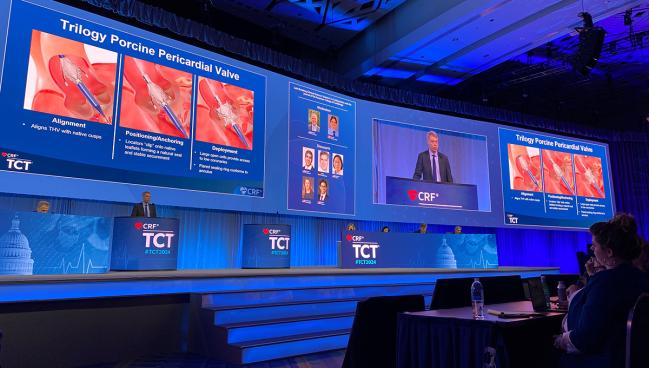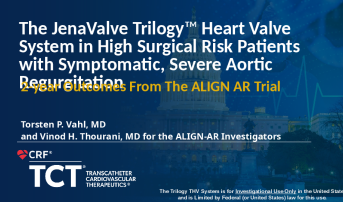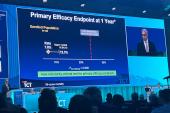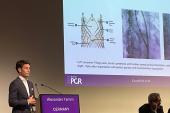ALIGN-AR at 2 Years Shows Promise for TAVI With Trilogy in Aortic Regurgitation
With the data under review by the FDA, experts estimate that a substantial population could potentially benefit.

WASHINGTON, DC—Further follow-up from the ALIGN-AR trial confirm the safety and continued efficacy of the Trilogy heart valve system (JenaValve) for the treatment of patients with severe, symptomatic aortic regurgitation (AR) at high risk for surgery.
At 2 years, the cardiac mortality rate was still lower than the study’s prespecified performance goal of 25% at 1 year, hemodynamics were excellent, rates of paravalvular leak were very low, and there were significant gains in quality of life, said Torsten P. Vahl, MD (NewYork-Presbyterian/Columbia University Irving Medical Center, NY), who presented the findings today at TCT 2024.
As reported by TCTMD, 1-year results showed that ALIGN-AR met its safety and efficacy goals compared with historic datasets and showed significant improvements in quality of life.
“There's currently no device approved in the United States to treat patients with aortic regurgitation with TAVR; sometimes patients are treated off label,” Vahl told TCTMD. The device received CE Mark approval in Europe in 2021 and has shown good initial real-world results.
One concern with using devices approved for aortic stenosis in AR is that the valve might sink into the ventricle given the lack of calcium to anchor it, said Vahl. The Trilogy device is equipped with locators that act like a paper clip to attach it to the native leaflets and provide stabilization as well as commissural alignment.
“From an interventional perspective, this is a really promising therapy and a very elegant device, in my opinion, with very good results,” said Wayne Batchelor, MD (Inova Heart and Vascular Institute, Fairfax, VA), during a press conference. “It's really encouraging to see those 2-year results look so favorable.”
Katherine Harrington, MD (Baylor Scott & White Medical Center, Plano, TX), who discussed the findings during the session said, “we're all very excited to have, hopefully, an on-label valve for aortic insufficiency. These patients are often higher risk than aortic stenosis patients, and although it's a smaller population, it's certainly an important unmet need.”
Two-Year Findings
The new analysis included 176 patients (mean age 75.5 years; 47.2% female) from the original study with 2-year follow-up.
All-cause mortality climbed from 7.8% at 1 year to 15.4% at 2 years, but there were only two additional cardiovascular deaths, increasing the rate from 6.2% at 1 year to 7.4% at 2 years.
“That implies that between year 1 and year 2, the vast majority of patients, 11 out of 13, experienced noncardiovascular death that we can attribute to the high rate of comorbidities,” Vahl said.
The rate of nondisabling stroke remained the same at 4.1% at both time points, and disabling stroke increased from 1.7% at 1 year to 2.3% at 2 years. There were no patients needing a new pacemaker or a surgery/intervention related to the device between years 1 and 2. There were two new incidents of major/life-threatening bleeding and one MI.
As for hemodynamics, mean gradient and valve effective orifice area were preserved from 1 to 2 years, while paravalvular regurgitation dropped from a rate of 8.2% at year 1 to 4.4% at year 2. Patients had consistently good LV remodeling and gains in quality of life as defined by NYHA functional class and KCCQ-OS at both 1 and 2 years.
According to Vahl, the US Food and Drug Administration is “looking at regulatory approval based on the 1-year data” and will now be evaluating these 2-year findings. His group will also begin enrolling patients early next year in the ARTIST trial, which will randomize patients eligible for surgery with moderate-to-severe and severe aortic regurgitation to SAVR or TAVI with the Trilogy device.
Future Potential
The potential patient population eligible for this kind of a valve could be “much wider than we actually see now,” Anna Sonia Petronio, MD (University Hospital, Pisa, Italy), predicted during a press conference.
Vahl agreed. “As it always happens, if we have no tools, no one sends us the patients,” he said. “As the tools are starting to show up, the referrals come as well.”
Diagnosis is improving as well, said press conference moderator David J. Cohen, MD (Cardiovascular Research Foundation, New York, NY, and St. Francis Hospital, Roslyn, NY). “We're also starting to realize that echo may not be the optimal way to diagnose aortic regurgitation,” he said. “There are many cases that don't meet echo criteria that can be picked up by MRI or CT.”
Even with echo, however, physicians are getting better at picking up AR, Vahl said.
If the device receives FDA clearance, Batchelor said he’d “definitely” use it, but that it remains uncertain how often. “I think there's a good population of patients who we're not seeing,” he said. “My curiosity is in 10 to 15 years, are we going to lower the threshold for treating? Because right now, aortic regurgitation guidelines are such that you have to have pretty significant left ventricular dilatation, and my gut feeling is, if we have a safe and efficacious device, it might lower that threshold for intervening, especially in the older, higher-risk patients who are not currently surgical candidates.”
The population will likely be smaller than those he treats with TAVI for aortic stenosis, Batchelor added.
This might vary with geography, Cohen noted. “In China, in particular, aortic regurgitation is nearly half of all of the aortic valve replacements that are done there,” he said. “It's a very different biology. And so there are some very large populations that really need dedicated aortic regurgitation valves.”
Yael L. Maxwell is Senior Medical Journalist for TCTMD and Section Editor of TCTMD's Fellows Forum. She served as the inaugural…
Read Full BioSources
Vahl TP. The JenaValve Trilogy heart valve system in high surgical risk patients with symptomatic, severe aortic regurgitation: 2-year outcomes from the ALIGN-AR trial. Presented at: TCT 2024. October 29, 2024. Washington, DC.
Disclosures
- Vahl reports receiving grant/research support from Edwards Lifesciences, Boston Scientific, Medtronic, and JenaValve and consultant fees/honoraria from 4C Medical, Abbott, Innovheart, and Philips.






Comments